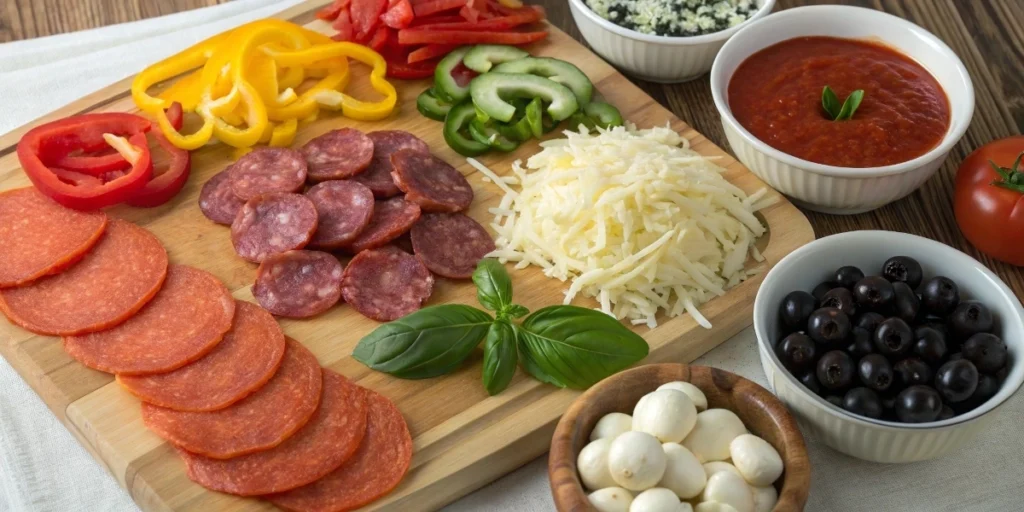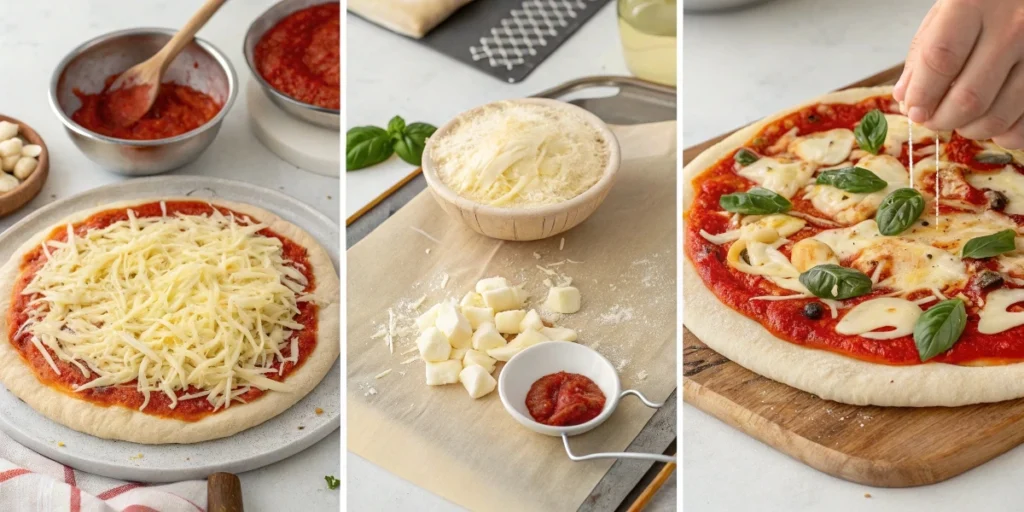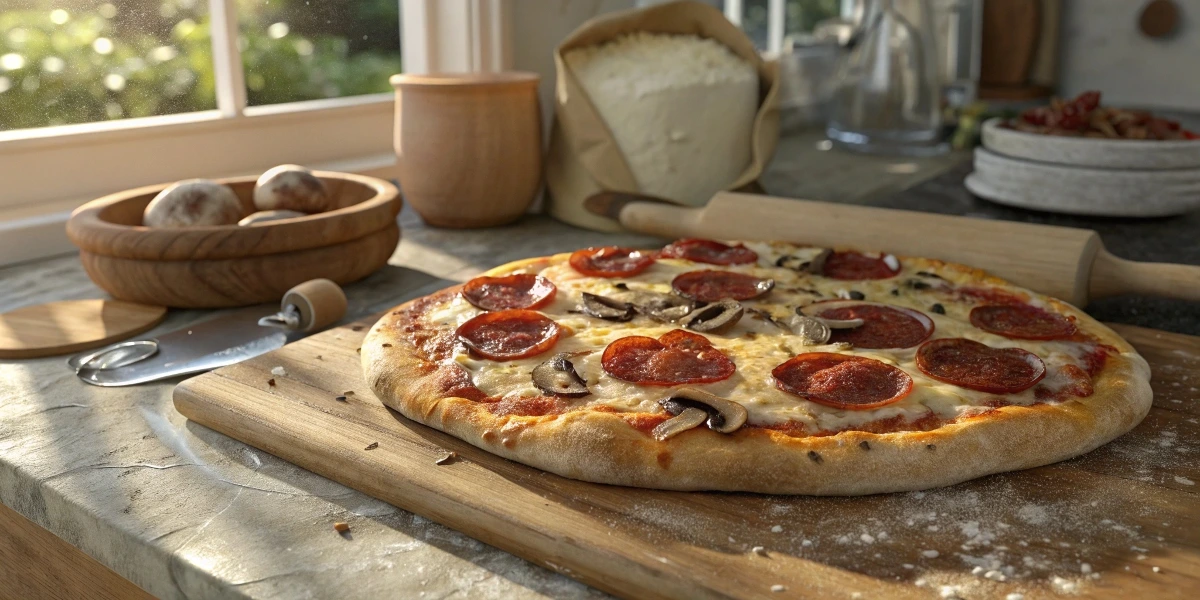Have you ever found yourself staring at a pizza menu, overwhelmed by the endless options for toppings? Whether you’re a classic pepperoni fan or someone who loves to get creative with exotic ingredients, the choices can be mind-boggling. But have you ever wondered why some toppings work perfectly together while others might leave you scratching your head? In this blog post, we’re diving into the world of pizza toppings, exploring what makes them special, how to mix and match, and why a well-chosen topping can elevate your pizza game to the next level.
Table of Contents
Overview: What Makes Pizza Toppings So Special?
Pizza toppings are what truly make each pizza unique. Whether you like them spicy, savory, or sweet, your topping choices define the flavor profile of your pizza. The great thing about pizza is that there are no wrong choices—just endless combinations to experiment with. Making pizza at home with your favorite toppings can be a fun and delicious activity.
Time and Difficulty
Preparing a pizza with delicious toppings can be quick and easy, especially if you’re using a pre-made crust. From start to finish, you can have a custom pizza ready in as little as 20-30 minutes! Whether you’re baking it in a traditional oven, a pizza stone, or even a grill, the process is generally straightforward, making it a great choice for beginner and experienced cooks alike.
Skill Level
Making pizza at home might sound like a complex task, but it’s actually one of the easiest dishes to prepare. There’s no need to stress about perfection—just have fun with your toppings and let the flavors speak for themselves! If you’re new to pizza making, you can always start with a simple crust and a few familiar toppings, and gradually work your way up to more gourmet combinations.
Essential Ingredients: What Goes Into a Perfect Pizza?

When it comes to pizza toppings, the key is to start with quality ingredients. Here’s a breakdown of the essentials, including some tasty alternatives!
1. The Base: Pizza Dough and Toppings
The dough is the foundation of your pizza. Whether you choose to make your own dough from scratch, buy pre-made dough, or use a ready-made crust, the dough needs to be soft and flavorful. It acts as the canvas for all your delicious toppings.
Alternatives:
- Gluten-Free Dough: For those with gluten sensitivities, gluten-free pizza dough is a great option.
- Cauliflower Crust: A low-carb alternative that’s perfect for those looking for a healthier option.
2. Sauce: A Flavorful Foundation
Most pizzas start with a tomato-based sauce, but you can also experiment with alternatives like pesto, white sauce, or BBQ sauce. The sauce helps bind the toppings together and adds flavor to the pizza.
Alternatives:
- Pesto Sauce: Perfect for a fresh, herby flavor.
- Alfredo Sauce: A creamy option that pairs well with chicken or veggies.
- BBQ Sauce: Ideal for a smoky, tangy twist, especially with grilled meats.
3. Cheese: The Melty Magic
Cheese is arguably the star of the pizza. Mozzarella is the most popular cheese for pizza because it melts beautifully and has a mild flavor that complements most toppings.
Alternatives:
- Cheddar Cheese: Adds a sharp, tangy flavor that goes well with meats.
- Parmesan Cheese: Perfect for a sprinkle on top for extra flavor.
- Vegan Cheese: For those avoiding dairy, plant-based cheeses are a great substitute.
4. Meats: Protein Power
Pizza toppings often feature various meats, from the classic pepperoni to bacon, sausage, or chicken. Meats add savory depth to your pizza, but don’t hesitate to try something new!
Alternatives:
- Turkey Pepperoni: A healthier, lower-fat version of the classic.
- Grilled Chicken: A lean protein that pairs well with veggies or BBQ sauce.
- Salami or Prosciutto: For a more upscale pizza experience.
5. Veggies: Freshness and Crunch
Veggies are a great way to balance out the richness of the cheese and meat. From bell peppers to onions, mushrooms, and olives, there’s a veggie for every taste.
Alternatives:
- Spinach: A great leafy green option that adds a little extra nutrition.
- Artichokes: For a unique and slightly tangy touch.
- Broccoli or Zucchini: Adds texture and nutrients without overpowering the other ingredients.
Step-by-Step Instructions: How to Make Pizza with Perfect Toppings?

Ready to build your dream pizza? Follow these simple steps to create a mouthwatering masterpiece with your favorite toppings!
1. Prepare the Dough
If you’re using store-bought dough, roll it out to your desired thickness. If you’re making it from scratch, knead the dough and let it rise until it doubles in size (about an hour). Then, roll it out on a floured surface to fit your pizza pan or stone.
2. Spread the Sauce for Perfect Pizza Toppings
Use a spoon to spread your chosen sauce evenly across the dough, leaving a small border for the crust. Be generous, but not too much—too much sauce can make the pizza soggy.
3. Add the Cheese
Sprinkle a layer of mozzarella cheese over the sauce. If you’re feeling adventurous, mix in some parmesan or cheddar for extra flavor. Make sure the cheese is spread evenly to help it melt nicely.
4. Pile on the Toppings
Now comes the fun part—adding your toppings! Start with the meats (if using), followed by vegetables, and then any additional toppings like olives or herbs. Don’t overdo it; you want each topping to shine, not to overwhelm the pizza.
5. Bake
Preheat your oven to 475°F (245°C). Place your pizza in the oven and bake for 10-15 minutes, or until the crust is golden and the cheese is bubbly and melted. Keep an eye on it to make sure it doesn’t burn!
Assembly: Building the Perfect Pizza
Now that you’ve gathered your ingredients, it’s time to assemble your pizza. The key to creating a balanced pizza is to distribute the toppings evenly. Try to think about textures and flavors: crispy bacon and soft mushrooms, tangy olives with creamy mozzarella, spicy pepperoni with sweet onions. The combinations are endless, so feel free to experiment!
Presentation Tips:
- Fresh Herbs: Add a sprinkle of fresh basil, oregano, or thyme after baking for a fresh touch.
- Olive Oil Drizzle: A little drizzle of olive oil before or after baking can elevate the flavors and make the pizza look extra glossy.
- Color Contrast: Use a mix of colorful veggies like red peppers, green spinach, and yellow corn for a visually stunning pizza.
Storage and Makeup Tips: Keeping Your Pizza Toppings Fresh
If you have leftover pizza, don’t worry! Proper storage is key to keeping it fresh.
Storing Pizza:
- Refrigerate: Store leftover pizza in an airtight container in the fridge for up to 3 days.
- Freeze: For longer storage, wrap the pizza tightly in plastic wrap and freeze it for up to 2 months.
Reheating Pizza:
- Oven: Reheat your pizza in the oven at 375°F (190°C) for 10-15 minutes to keep the crust crispy.
- Stovetop: Heat a skillet over medium heat and place the pizza in the skillet, covering it with a lid to help melt the cheese.
Recipe Variations: Get Creative with Your Pizza Toppings
Pizza is all about creativity! Here are a few ideas to take your pizza to the next level:
1. Breakfast Pizza
Top your pizza with scrambled eggs, crispy bacon, and hash browns for a delicious breakfast treat.
2. Veggie Lover’s Pizza
Go all out with a variety of veggies—spinach, mushrooms, onions, olives, and bell peppers—plus a drizzle of balsamic glaze.
3. BBQ Chicken Pizza
Swap the tomato sauce for BBQ sauce, then top with grilled chicken, red onions, and cilantro for a smoky, tangy flavor.
Conclusion: The Endless Possibilities of Pizza Toppings
The beauty of pizza toppings is their versatility. There’s no limit to what you can put on your pizza—whether you’re keeping it simple with pepperoni and cheese, or going all out with exotic toppings like goat cheese and figs. Pizza is all about experimenting and finding your perfect combination. So, next time you’re in the kitchen, don’t be afraid to get creative and make your dream pizza!
FAQs About Pizza Toppings
Q1: Can I use frozen pizza dough? Yes, frozen pizza dough is a convenient option. Just let it thaw in the fridge for a few hours before using it.
Q2: Are there any healthy pizza topping options? Absolutely! Opt for lean proteins like grilled chicken, load up on veggies, and use a whole-wheat or cauliflower crust for a healthier pizza.
Q3: Can I store leftover pizza in the freezer? Yes! Wrap your leftover pizza tightly in plastic wrap and freeze it for up to 2 months. Just reheat it in the oven when you’re ready to enjoy it again!
Q4: How do I make a gluten-free pizza? Use gluten-free pizza dough or a cauliflower crust. There are many gluten-free pizza sauces and cheeses available too!
No matter your taste, there’s a perfect pizza topping combination out there for you. So, roll up your sleeves, get creative, and enjoy making your very own pizza masterpiece.

Classic Pepperoni and Mushroom Pizza
Ingredients
Notes
Step-by-Step Instructions
1. Prep Time: 15 minutes
- Preheat your oven to 475°F (245°C) . If you have a pizza stone or baking steel, place it in the oven to heat up.
- In a small bowl, mix the olive oil, oregano, and garlic powder together to make a simple seasoning drizzle.
2. Shape the Dough
- On a lightly floured surface, roll out the pizza dough into a circle about 12 inches in diameter.
- Transfer the dough to a piece of parchment paper or a pizza peel dusted with cornmeal.
3. Add Sauce and Toppings
- Spread the marinara sauce evenly over the dough, leaving a small border around the edge.
- Sprinkle the shredded mozzarella cheese over the sauce.
- Top evenly with sliced pepperoni and mushrooms.
- Lightly drizzle the seasoned olive oil mixture over the top.
4. Bake the Pizza
- Bake in the preheated oven for 10–12 minutes , or until the crust is golden brown and the cheese is bubbly and slightly charred at the edges.
5. Resting Time: 5 minutes
- Remove the pizza from the oven and let it rest for 5 minutes before slicing. This helps the cheese set and makes it easier to cut.
6. Serve
- Slice into 4 pieces and serve warm. Garnish with fresh basil leaves if desired.
